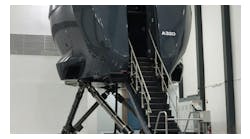For three days, members of the Aviation Technician Education Council’s (ATEC) board beat a path around the nation’s capital to advocate for better policies to support aviation maintenance education. This “boots on the ground” effort is sorely needed: Aviation continues to experience rapid growth while at the same time a major crisis is looming around the ability to find and retain skilled workers.
ATEC’s message on Capitol Hill was clear and concise centered on four major initiatives:
First, revitalize outdated FAA maintenance technical school regulations. In 2008, an Aviation Rule Making Advisory Committee (ARAC) provided 11 clear recommendations. The ARAC focused on removing the appendixes of Part 147 – notably the curriculum requirements – and placing them in operation specifications to make revisions easier. Making the rule more flexible would allow A&P schools to deemphasize outdated tasks and make way for advancing technology needed by industry. The FAA has been slow to move on updating Part 147, so ATEC has enlisted Congress in the effort.
Secondly, make STEM a top education policy priority. Aviation maintenance education is a STEM career path and many of the council’s member schools have greater than 90 percent placement in the industry. We need more students who see aviation maintenance as a pathway to a successful life. As a recognized part of the STEM community, an AMT career becomes a more easily understood part of that path.
Third, provide the FAA the resources to do its job. As Congress grapples with reauthorization of the FAA, the agency needs long-term, responsible funding so it can begin to prioritize critical tasks and meet the needs of its certificate holders. It is hard for any organization to be successful with no strategic funding plan.
Finally, ensure proper classification of aviation workers. The council has put considerable time into analyzing the standard occupational classification (SOC) system utilized by government agencies to capture the American workforce. When it comes to aviation maintenance careers, the system needs help. Bad classification creates bad data and produces bad analysis. Based on this faulty system, the Government Accountability Office (GAO) reported the aviation maintenance workforce showed no shortage of skilled workers. A better structure is needed to help preserve the great aerospace industry and ATEC is committed to find these solutions.
Legislative Leadership Award
While in Washington, the ATEC board presented its first Legislative Leadership Award to Rep. Bradley Byrne (R-AL). The award recognizes elected officials with long professional experience and deep personal commitment to technical education and skills training. As a former member of the Alabama Board of Education and chancellor of the state’s Department of Postsecondary Education, Rep. Byrne has committed a significant portion of his public life to the future of the American workforce.
FAA Meetings
While time on Capitol Hill was important, the ATEC board paid attention to regulators – visiting the FAA’s Aircraft Maintenance Division (AFS-300) – while in Washington. ATEC has been working closely with AFS-300 over the last four years to develop regulatory guidance and create a path for regulatory change in Part 147. A great deal of work has already been completed: Operations Specifications are now required in all Part 147 aviation maintenance training schools (AMTS), a mandated inspector training course has been developed in Oklahoma City, distance education is now a reality, and ATEC has worked with its membership and industry to draft regulatory guidance to bring about a Notice of Proposed Rule Making (NPRM).
ATEC is not alone in this belief that Part 147 must change or be bypassed with other educational processes. ATEC met with President Jennifer McNelly of the Manufacturing Institute and Executive Director James Brown of the STEM Education Coalition. Both had tremendous knowledge of the educational challenges faced not just in aerospace but in many technical training sectors. The void of middle-skills workers is negatively impacting growth and more must be done to educate students and parents that the pathway to a successful career is not always a four-year degree track.
Industry Meetings
Airlines for American and the Regional Airlines Association provided the board real insight concerning the importance of teaching voluntary safety programs to our students. The real education came when ATEC reported to these industry allies that there is no mention of safety or maintenance human factors required to be taught within the current regulations. After their initial horror subsided, representatives of both groups agreed to help correct this deficiency.
Whether one talks to an individual congressman, members of the industry, or “alphabet soup” partners everyone would say that something must be done to move things forward and update Part 147. Out of shear necessity ASTM International has formed the F46 Committee to develop educational standards for aerospace personnel. I applaud this effort but also don’t understand why the FAA has been unwilling to address Part 147. There are over 160 schools that stand ready to meet the educational needs of the industry if the FAA would just do its job.
ATEC accomplished a great deal in Washington, solidifying its place as the industry association for aviation maintenance technical education. We look forward to our mission in training the next generation of aerospace workers. To aid in this effort, I call upon industry to help push Part 147 rulemaking over center to allow adaptive and advancing technologies to be required in all Part 147 schools.
ATEC is a partnership of FAA-certificated aviation maintenance training schools. The council is dedicated to fostering aviation maintenance education and providing industry with skilled labor. To learn more, visit www.atec-amt.org.
Ryan Goertzen currently holds the position of Chief Aviation and Academic Officer with Spartan College of Aeronautics and Technology. Ryan started his career at Spartan College as the Vice President of Education and later become the President of the Tulsa Campus. Prior to joining Spartan College Ryan worker for AAR Corp in Oklahoma City as the Director of Training and ASAP Manager. Prior to AAR Ryan worked with Air Wisconsin Airlines as a Pilot Instructor, Manager of Maintenance Training and ASAP Manager. Ryan is the current president of ATEC.


